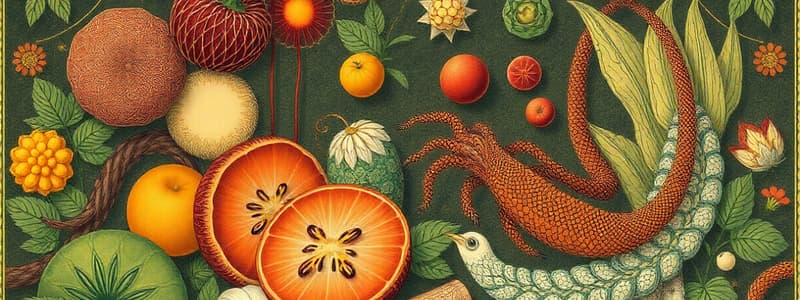Podcast
Questions and Answers
What is the primary role of food for living organisms?
What is the primary role of food for living organisms?
- To act as a source of shelter
- To facilitate reproduction only
- To provide energy and promote growth (correct)
- To serve as a source of carbon alone
Which type of organism can prepare its own food through photosynthesis?
Which type of organism can prepare its own food through photosynthesis?
- Herbivores
- Heterotrophic organisms
- Autotrophic organisms (correct)
- Carnivores
Which of the following is an example of a carnivore?
Which of the following is an example of a carnivore?
- Tiger (correct)
- Human
- Cow
- Goat
Which part of the plant do we obtain nuts from?
Which part of the plant do we obtain nuts from?
What is a common source of protein found in animal food products?
What is a common source of protein found in animal food products?
Which of the following food products is rich in carbohydrates?
Which of the following food products is rich in carbohydrates?
What type of food do omnivores consume?
What type of food do omnivores consume?
Which edible plant part is used to produce spices like cinnamon and coriander?
Which edible plant part is used to produce spices like cinnamon and coriander?
Which type of food do herbivores primarily eat?
Which type of food do herbivores primarily eat?
From which animal do we typically obtain milk?
From which animal do we typically obtain milk?
Flashcards are hidden until you start studying
Study Notes
Importance of Food
- Food is essential for survival, providing energy and supporting health and growth.
- It repairs worn tissues, promotes body development, and strengthens the immune system against diseases.
Types of Organisms by Food Source
- Autotrophic Organisms: Produce their own food through photosynthesis using simple organic substances.
- Heterotrophic Organisms: Cannot manufacture their own food and obtain nutrition from other animals or plants.
Classification of Animals by Diet
- Herbivores: Consume only plant materials (e.g., cows, goats, sheep).
- Carnivores: Feed on the flesh of other animals (e.g., tigers, lions).
- Omnivores: Eat both plants and animals (e.g., dogs, cats, humans).
Sources of Food
- Food sources include both plants and animals.
Plant Food Products
- Flowers: Edible flowers include cauliflower and broccoli; cloves are dried flower buds.
- Fruits: Edible fruits come from many plants, e.g., mangoes, apples, pears; types used as spices include black and red pepper; vegetables include tomatoes and cucumbers.
- Seeds: Edible seeds are used for cereals (rice, wheat), pulses (grams, peas), and oil seeds (groundnuts, mustard).
- Spices: Enhance food flavor and aroma (e.g., cinnamon, pepper).
- Nuts: Include almonds, cashews, walnuts.
- Beverages: Coffee beans and tea leaves are popular plant-based drinks.
Animal Food Products
- Milk Products: Obtained from cows, buffaloes, goats; includes curd, butter, and paneer; rich in proteins, fats, carbohydrates.
- Eggs: Sourced from hens and ducks; excellent protein source.
- Meat: Comes from various animals, including hens and goats; a rich protein source.
- Honey: Produced by honeybees; has medicinal properties and a very long shelf life.
- Animal Oils: Derived from animal sources, used for cooking and nutrition.
Edible Plant Parts
- Roots: Includes carrots, turnips, and beetroot.
- Stems: Edible forms include sugarcane and potatoes; garlic bulbs are considered modified stems.
- Leaves: Green leaves (e.g., spinach, cabbage) are good calcium sources.
Honey Composition
- Approximately 17.1% water content.
- Contains fructose (38.5%) and glucose (31%).
- Includes a small amount of proteins, enzymes, vitamins, and minerals.
- Rich in antioxidants and comprises about 18 different amino acids.
Studying That Suits You
Use AI to generate personalized quizzes and flashcards to suit your learning preferences.




